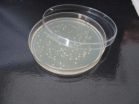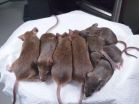(Press-News.org) What do cancer cells, weeds, and pathogens have in common? They all evolve resistance to the treatments that are supposed to eliminate them. However, researchers developing the next generation of antibiotics, herbicides, and anti-cancer therapeutics rarely come together to explore the common evolutionary principles at work across their different biological systems. The new American Academy of Microbiology report "Moving Targets: Fighting Resistance in Infections, Pests, and Cancer" concludes that scientists working on different kinds of treatments have much to learn from each other. Applying lessons learned about the evolution of resistance in different biological systems during the earliest stages of drug and pesticide design could lead to more effective treatments for patients, farmers, and public health organizations.
Do you think the oncologists at a cutting-edge research hospital ever sit down with local farmers? Do you think the pharmaceutical researchers developing the next generation of anti-HIV drugs spend any time with the plant scientists working on the next generation of Roundup Ready soybeans? If your answer to both questions is no, you would be mostly right. Even though all of these people are dealing with exactly the same evolutionary phenomena, they do not recognize themselves as a single scientific community and rarely get a chance to learn from each other. What they all have in common is that they are trying to eliminate an unwanted living entity but the treatments they develop eventually lose effectiveness because the target evolves resistance.
The emergence of resistance is a phenomenon with ancient evolutionary roots, although the human role in triggering resistance was little appreciated before the advent of widespread antibiotic and pesticide use in the 1950s. In Silent Spring, the prescient Rachel Carson wrote in 1962 that "by their very nature chemical controls are self-defeating, for they have been devised and applied without taking into account the complex biological systems against which they have been blindly hurled." Sadly, in the fifty years since Silent Spring was published, biologists, doctors, and farmers continue to be plagued with resistance evolution by the species they seek to control. This phenomenon is witnessed in medicine in the emergence of antibiotic resistance and when tumors become intractable to standard anti-cancer medications, in agriculture when insecticides and herbicides lose effectiveness, and in public health when disease-carrying insects develop resistance to control strategies. The report "Moving Targets: Fighting Resistance in Infections, Pests, and Cancer" makes clear that a multi-disciplinary approach to the phenomenon of resistance can be very powerful.
###
A PDF of Moving Targets can be found here: http://bit.ly/XaKaSY.
The American Academy of Microbiology is the honorific leadership group of the American Society of Microbiology. The mission of the Academy is to recognize scientific excellence, as well as foster knowledge and understanding in the microbiological sciences. A full list of Academy colloquia reports can be found at http://academy.asm.org/colloquia. For more information about the American Society for Microbiology, visit http://www.asm.org. END
American Academy of Microbiology releases resistance report
2013-03-07
ELSE PRESS RELEASES FROM THIS DATE:
Dual systems key to keeping chromosomes intact
2013-03-07
USC scientists have discovered how two different structural apparatuses collaborate to protect repetitive DNA when it is at its most vulnerable – while it is being unzipped for replication.
The centromere—the center of the "X" shape of a chromosome—contains repeated DNA sequences that are epigenetically coded to attract so-called heterochromatin proteins. This protects the structure to ensure that the chromosomes separate properly. If the heterochromatin is lost (due to mutations in the cell), the repetitive DNA becomes vulnerable to rearrangements and recombination. ...
New hypothesis: Why bacteria are becoming increasingly more resistant to antibiotics
2013-03-07
According to his theory, bacteria that are non-resistant to antibiotics acquire said resistance accidentally because they take up the DNA of others that are resistant, due to the stress to which they are subjected.
A University of Granada researcher has formulated a new hypothesis concerning an enigma that the scientific community has still not been able to solve and which could revolutionise the pharmaceutical industry: Why are bacteria becoming increasingly more resistant to antibiotics? His work has revealed that the use of antibiotics can even cause non-resistant bacteria ...
New gender benchmarking study: India is making slow progress in advancing women in S & T
2013-03-07
Delhi, March 7, 2013 - In the first gender benchmarking study of its kind, researchers have found that numbers of women in the science, technology and innovation fields are alarmingly low in the world's leading economies, and are actually on the decline in many, including the United States. India's low overall ranking in the study shows slow progress despite women friendly policies which have been in place for a number of years.
The full gender benchmarking study maps the opportunities and obstacles faced by women in science in Brazil, South Africa, India, the Republic ...
New gender benchmarking study: South Africa ranks low on women participating in STI
2013-03-07
Cape Town, March 7, 2013 – In the first gender benchmarking study of its kind, researchers have found that numbers of women in the science, technology and innovation fields (STI) are alarmingly low in the world's leading economies, and are actually on the decline in many, including the United States. For South Africa, results show that women have more opportunities available to them than ever before, however, their participation in the science, technology and innovation workforce remains low.
The full gender benchmarking study maps the opportunities and obstacles faced ...
Japanese researchers succeed in making generations of mouse clones
2013-03-07
Using the technique that created Dolly the sheep, researchers from the RIKEN Center for Developmental Biology in Kobe, Japan have identified a way to produce healthy mouse clones that live a normal lifespan and can be sequentially cloned indefinitely.
Their study is published today in the journal Cell Stem Cell.
In an experiment that started in 2005, the team led by Dr. Teruhiko Wakayama has used a technique called somatic cell nuclear transfer (SNCT) to produce 581 clones of one original 'donor' mouse, through 25 consecutive rounds of cloning.
SNCT is a widely ...
High BMI linked to heart attack, stroke in young women
2013-03-07
SAN FRANCISCO (March 7, 2013) —A nationwide study of women in Denmark who are of child-bearing age finds that those who are obese appear to have a much greater risk of heart attack or stroke, according to research being presented at the American College of Cardiology's 62nd Annual Scientific Session.
In fact, women with a high body mass index (BMI)—a measure of the body's fat content—that is indicative of obesity were twice as likely as those of normal weight to suffer a potentially life-threatening heart attack or stroke within just four to five years following childbirth. ...
Duckweed as a cost-competitive raw material for biofuel production
2013-03-07
The search for a less-expensive, sustainable source of biomass, or plant material, for producing gasoline, diesel and jet fuel has led scientists to duckweed, that fast-growing floating plant that turns ponds and lakes green. That's the topic of a report in ACS' journal Industrial & Engineering Chemistry Research.
Christodoulos A. Floudas, Xin Xiao and colleagues explain that duckweed, an aquatic plant that floats on or near the surface of still or slow-moving freshwater, is ideal as a raw material for biofuel production. It grows fast, thrives in wastewater that has ...
First discovery of a natural topological insulator
2013-03-07
In a step toward understanding and exploiting an exotic form of matter that has been sparking excitement for potential applications in a new genre of supercomputers, scientists are reporting the first identification of a naturally occurring "topological insulator" (TI). Their report on discovery of the material, retrieved from an abandoned gold mine in the Czech Republic, appears in the ACS journal Nano Letters.
Pascal Gehring and colleagues point out that synthetic TIs, discovered only a decade ago, are regarded as a new horizon in materials science. Unlike conventional ...
Report offers an in-depth examination of health centers' role in family planning
2013-03-07
WASHINGTON and NEW YORK—A report released today by the George Washington University School of Public Health and Health Services (SPHHS) and the RCHN Community Health Foundation offers the first-ever in-depth examination of health centers' role in access to family planning. The report finds that virtually all health centers furnish family planning services to some extent but for both financial and non-financial reasons, only 1 in 5 is able to offer access to the full range of contraceptive services.
The report offers a series of recommendations to strengthen performance, ...
Test-taking may improve learning in people of all ages
2013-03-07
WASHINGTON – Older adults who haven't been in school for a while are as capable of learning from tests as younger adults and college students, according to new research published by the American Psychological Association.
No matter their age or if they work or go to college full time, people appear to learn more when tested on material, rather than simply rereading or restudying information, according to research published online in the APA journal Psychology and Aging.
"The use of testing as a way to learn new information has been thoroughly examined in young students. ...

